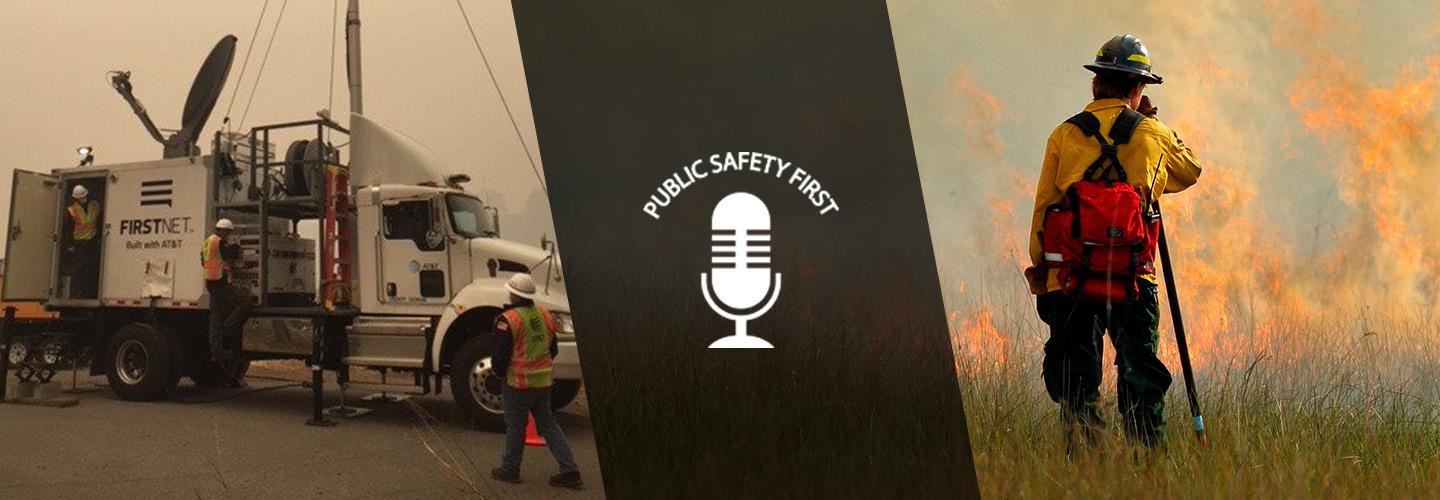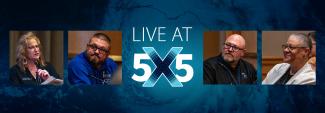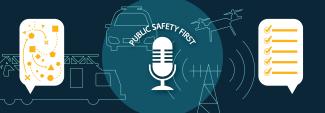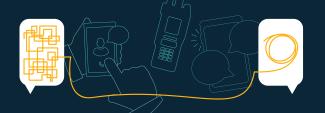Summary
Guest
Thomas Randall, FirstNet Authority Senior Public Advisor
Ruben Ramirez, Falfurrias Fire Department Chief
Transcript
Preview
Episode 70: Fighting wildfires in Southern Texas with FirstNet
THOMAS RANDALL: Welcome to the Public Safety First podcast. I'm Thomas Randall. I serve as Senior Public Safety Advisor for the First Responder Network Authority for the region six states, including Texas. Today, I'm here in McAllen, Texas, and I'm joined by Chief Ruben Ramirez of the Falfurrias Fire Department. Chief, welcome to the podcast.
RUBEN RAMIREZ: Thank you for having me.
Episode 70: Fighting wildfires in Southern Texas with FirstNet
THOMAS RANDALL: Welcome to the Public Safety First podcast. I'm Thomas Randall. I serve as Senior Public Safety Advisor for the First Responder Network Authority for the region six states, including Texas. Today, I'm here in McAllen, Texas, and I'm joined by Chief Ruben Ramirez of the Falfurrias Fire Department. Chief, welcome to the podcast.
RUBEN RAMIREZ: Thank you for having me.
THOMAS RANDALL: We spoke last summer about the Brooks County fire and how you all responded to that. And that's our purpose today, to sit down and talk about some of the solutions that Falfurrias fire Department utilized in fighting that rural fire. But before we get started, I wanted to give you a chance to introduce yourself and tell us a little bit about the department.
RUBEN RAMIREZ: I've been in the fire service for 17 years. I'm originally from McAllen but I was raised in Falfurrias. I was moved there as a kid with my dad who became a Border Patrol agent there. And, watching him get dressed every morning as a first responder sparked the interest more to be a first responder. When I joined the fire service I said, well, I'll take this route. I've been there for 17 years. I've been the fire chief now for going on six years. I'm the emergency management coordinator, the fire chief, the EMS coordinator, the flood plan administrator, and the two on one coordinator for the county and the city. Our fire department is primarily a volunteer department. I'm the only position that's paid for the county and the city. We consist of about 30 members, all volunteers. We have about 19 apparatuses, and we cover about 9000miwe do a lot of wildfire activity in our region. So that's primarily our response.
THOMAS RANDALL: So, we had an active fire season last summer and you guys got involved in a pretty big fire down in Brookes County. What was going on with fighting that particular fire?
RUBEN RAMIREZ: The fire, I think, turned out to be right around 6500 acres once it was all said and done. The fire was in a very complex area, reaching over about five different properties, from large property that's about 40,000 acres, to a smaller ranch that's about 300 acres. The thing that made this fire very unique is the topography of the location. and the terrain. So, we had very sandy, sandy loam, surface and kind of like a sand dune type topography there. So, it was a very challenging fire for equipment and firefighters to get it put out and to get it buttoned up the correct way. And then, there was no communication? It was 22 miles from the nearest highway. So, access to it was very limited. And then once you did get access to it, if you had a vehicle or a fire apparatus that can travel in the sand, that's the only thing that was going to make it out there.
THOMAS RANDALL: Communications became a big challenge. And it's just because that area is, like you said, so rural. We didn't have any tower sites that were even in the vicinity of where the fire was burning. It wasn't that we lost communications, we didn't have communications at all. That being the challenge, what was your thought on how FirstNet could provide you a solution?
RUBEN RAMIREZ: In the fire service, we depend a lot on radio. So, the only radio communication we had was on a radio-to-radio basic talk around channel. So, Mr. Champion, with FirstNet, he keeps in contact pretty regularly. He says, hey, this is what we have to offer. Tell us what you need and what's going on. How's your communication on the ground? So, I gave him a quick briefing on the communication on the ground. He says, I'm on my way. I got something that's going to give a temporary fix, but let's get the cow rolling, to you guys. After we got the cow, he showed up with his rapid deployment pack. we set it up on our communications trailer and we were up and going. We were able to start mapping the fire. We were able to start seeing our weather conditions. We had great communication and instant command, but we had no communications to the firefighters in the field. So, it was pretty much relaying, we had to send scouts out to go and map the fire manually and then come back and start mapping it on the laptops. And then came the cow. And that just changed everything. We started having communications all the way around the fire, to the far end of the fire, to the closest up to the cow. It was phenomenal.
THOMAS RANDALL: And it provided you communications in an area where there were no communications.
RUBEN RAMIREZ: Oh, absolutely. Yeah. Even property owners that were driving through the area, Had been hearing about FirstNet. They're like, hey, what's going on? What'd you guys do over there? We got communications over here. I said, well, we got a temporary site that's going to keep us up and running for a little while.
THOMAS RANDALL: And, as we look at the different responders that came to support you all, did you have mutual aid from other agencies that came in?
RUBEN RAMIREZ: Yeah, we had over 40 agencies that responded. We had about 108 personnel on the fire in total. So, all the way from up just south of San Antonio, all the way down to from Brownsville, they were on this fire.
THOMAS RANDALL: And they were able also to communicate with you based on this connectivity?
RUBEN RAMIREZ: Absolutely. Yes, sir.
THOMAS RANDALL: Outstanding. If you just wanted to explain a little bit more about what device did they send down to you and then what type of technologies were you guys looking at? Was it mapping? Was it text? Was it chat? Was it location services? You know what different things were you trying to do with the technology that this SatCOLT brought to you?
RUBEN RAMIREZ: On our incident command trailer we have different stations in there. one of the biggest things that we needed the data for was to do our spot weathers and we were also doing mapping. We were doing a couple star request, our operational plans and then our PIO, right. Pushing out information. So, those are the majority of what we needed the data for. But once we got it out with the larger device, we were able to communicate around the entire fire. So, 6500 acres, we put it to bed in two days, but then we had an additional three days of mop up.
THOMAS RANDALL: When the rapid deployment kit was delivered to the scene, you guys were able to establish communications at the incident command, right. And, and was limited to that general area. But once the SatCOLT arrived, it provided you enough territory coverage to where you could cover to all of your line firefighters.
RUBEN RAMIREZ: The rapid deployment kit brought our command center back to life. But once the other equipment arrived, then we opened up the line of communications out on the on the fire ground and that helped tremendously. So, we were able to communicate all the way around the fire. our mapping software was able to track the firefighter as he as he mapped the entire fire. And we were able to project that to the other fires. We're able to update our improvement line. We have an app where we can show the firefighters outside our command center has a large screen and we can put that screen up and we can manually type in what's been where or where there's been fire line put in, or if we need to address something, we can put that up there so all the firefighters can see it on their devices.
THOMAS RANDALL: So, mapping plays a huge component. So, does being able to look at the weather, right?
RUBEN RAMIREZ: Yes, sir. And communications. The fire was so large that we couldn't communicate with even the talk around radios because we had no repeated channels out there. So, to communicate back with the section chief and say, hey, this is what I'm seeing on my side of the fire? Can you send me a dozer this way? I need more personnel or we're good on mopped up here. We're moving on to the next the side of the fire. So, yeah, great communication.
THOMAS RANDALL: When we talked at the conference that we talked at last summer, you had made a comment that you really never did think that you would use something like this. Tell me a little bit more about that.
RUBEN RAMIREZ: You go to training, you go to conferences, you can travel all around the US, all around the world. But it's when it actually happens, when you can actually benefit from it, then it comes to a different light, right? And you have a different aspect on how it all works. the FirstNet Authority came out about a few years ago. We started hearing about it and said, okay, great, we're from a very rural community, so anything that comes out, it's like, okay, we'll get it eventually, right? this was totally different. I mean, we got to use it hands-on in the field and really opened our eyes to what's out there and what FirstNet has to offer. And I think now, the sheriff's office, the city of Falfurrias, everybody is now utilizing a lot more of FirstNet equipment. And that's the route we're going as well.
THOMAS RANDALL: Is there anything out of your experience that we would need to improve on. How was that process?
RUBEN RAMIREZ: No, I think everything's great. after the incident, it was a lot of communication with the FirstNet team. That exact same question was asked, what can we do to improve? how did it work for you? And everything went great. Everything went phenomenal. dealing with the FirstNet staff, I mean, we can even demo products. So, if we have to build an apparatus, we can start looking into the future with the FirstNet Authority.
THOMAS RANDALL: Outstanding. And what brought you to us to begin with?
RUBEN RAMIREZ: Oh, it was definitely the FirstNet Authority staff that we have here locally, the knowledge of what was out there and what they had to offer brought us to the table. And then, knowing more and more of the resources that are available, and now we use it day to day. Our sheriff's office is using FirstNet. The city of Falfurrias is using FirstNet. And we're buying more and more devices. I mean, I'll tell you this, one of my assistants is real big on FirstNet as well. And he says, hey, take this, put this in the truck. We're going to go demo this. See, because I traveled to these rural places all the time, right? To meet with ranchers and property owners to discuss wildfire mitigation. And I go out there and I came back and I said, John, let's order more of these things, you know, they're phenomenal. Right? I can tell you that every single department in our county and city by the end of this year will be using FirstNet in some form or fashion.
THOMAS RANDALL: Thanks, Chief, for taking the time to speak with us today. It's been great to have you on the podcast and we really appreciate your participation and the information that that you brought, not only to us locally, but to some of the other rural fire agencies that have a chance to learn from some of the experiences that you all have had.
RUBEN RAMIREZ: Thank you for having me. Apprecia























